Understanding and Leading Change: Blake Logitech Report
VerifiedAdded on 2023/01/09
|11
|2571
|25
Report
AI Summary
This report delves into the critical aspects of change management and leadership, focusing on the case of Blake Logitech. It begins by examining the drivers of change, such as competition, growth planning, and customer needs, and discusses measures to mitigate negative impacts, including creating urgency, providing training, and motivating employees. The report then applies change management models like Kurt Lewin's theory and highlights the importance of transformational leadership. Force field analysis is utilized to identify driving and resisting forces, followed by an analysis of barriers to change, including lack of coordination, organizational culture (using Schein’s model), and self-efficacy perceptions. The report concludes by discussing how these factors influence leadership decision-making and strategies for leading change, emphasizing the need to address resistance and leverage driving forces effectively. The report is designed to provide a comprehensive overview of change management principles and their application in a real-world business context.
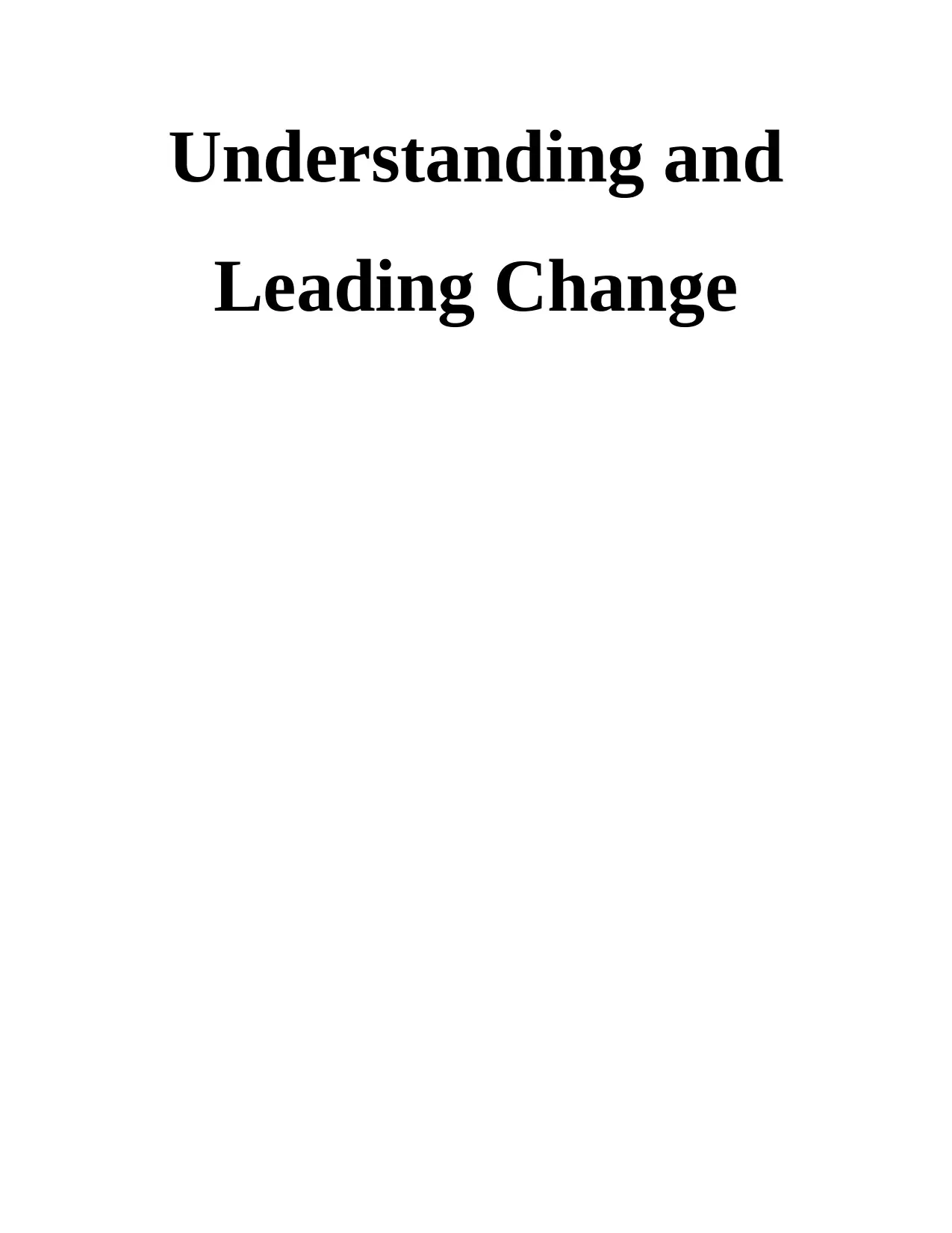
Understanding and
Leading Change
Leading Change
Paraphrase This Document
Need a fresh take? Get an instant paraphrase of this document with our AI Paraphraser
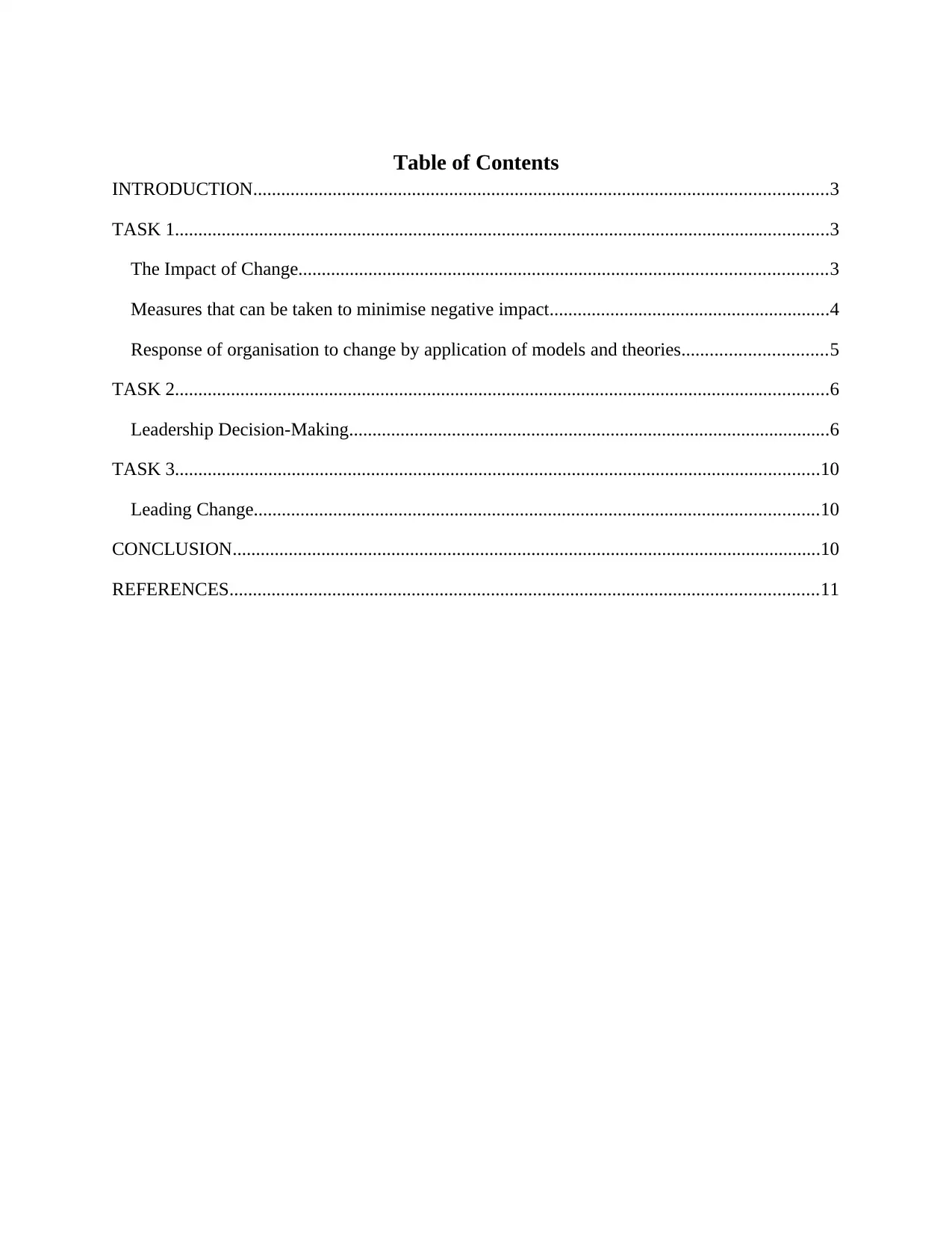
Table of Contents
INTRODUCTION...........................................................................................................................3
TASK 1............................................................................................................................................3
The Impact of Change.................................................................................................................3
Measures that can be taken to minimise negative impact............................................................4
Response of organisation to change by application of models and theories...............................5
TASK 2............................................................................................................................................6
Leadership Decision-Making.......................................................................................................6
TASK 3..........................................................................................................................................10
Leading Change.........................................................................................................................10
CONCLUSION..............................................................................................................................10
REFERENCES..............................................................................................................................11
INTRODUCTION...........................................................................................................................3
TASK 1............................................................................................................................................3
The Impact of Change.................................................................................................................3
Measures that can be taken to minimise negative impact............................................................4
Response of organisation to change by application of models and theories...............................5
TASK 2............................................................................................................................................6
Leadership Decision-Making.......................................................................................................6
TASK 3..........................................................................................................................................10
Leading Change.........................................................................................................................10
CONCLUSION..............................................................................................................................10
REFERENCES..............................................................................................................................11
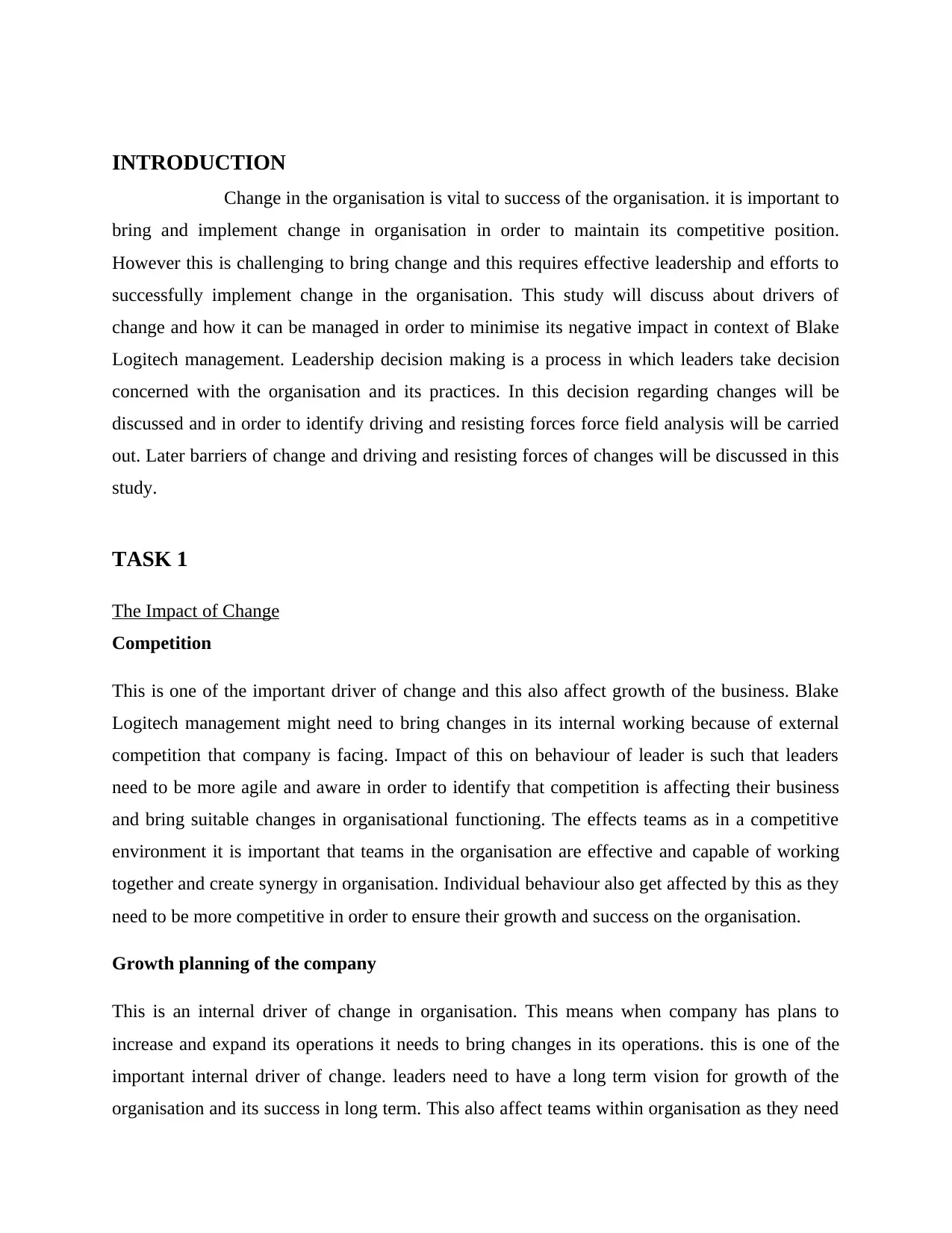
INTRODUCTION
Change in the organisation is vital to success of the organisation. it is important to
bring and implement change in organisation in order to maintain its competitive position.
However this is challenging to bring change and this requires effective leadership and efforts to
successfully implement change in the organisation. This study will discuss about drivers of
change and how it can be managed in order to minimise its negative impact in context of Blake
Logitech management. Leadership decision making is a process in which leaders take decision
concerned with the organisation and its practices. In this decision regarding changes will be
discussed and in order to identify driving and resisting forces force field analysis will be carried
out. Later barriers of change and driving and resisting forces of changes will be discussed in this
study.
TASK 1
The Impact of Change
Competition
This is one of the important driver of change and this also affect growth of the business. Blake
Logitech management might need to bring changes in its internal working because of external
competition that company is facing. Impact of this on behaviour of leader is such that leaders
need to be more agile and aware in order to identify that competition is affecting their business
and bring suitable changes in organisational functioning. The effects teams as in a competitive
environment it is important that teams in the organisation are effective and capable of working
together and create synergy in organisation. Individual behaviour also get affected by this as they
need to be more competitive in order to ensure their growth and success on the organisation.
Growth planning of the company
This is an internal driver of change in organisation. This means when company has plans to
increase and expand its operations it needs to bring changes in its operations. this is one of the
important internal driver of change. leaders need to have a long term vision for growth of the
organisation and its success in long term. This also affect teams within organisation as they need
Change in the organisation is vital to success of the organisation. it is important to
bring and implement change in organisation in order to maintain its competitive position.
However this is challenging to bring change and this requires effective leadership and efforts to
successfully implement change in the organisation. This study will discuss about drivers of
change and how it can be managed in order to minimise its negative impact in context of Blake
Logitech management. Leadership decision making is a process in which leaders take decision
concerned with the organisation and its practices. In this decision regarding changes will be
discussed and in order to identify driving and resisting forces force field analysis will be carried
out. Later barriers of change and driving and resisting forces of changes will be discussed in this
study.
TASK 1
The Impact of Change
Competition
This is one of the important driver of change and this also affect growth of the business. Blake
Logitech management might need to bring changes in its internal working because of external
competition that company is facing. Impact of this on behaviour of leader is such that leaders
need to be more agile and aware in order to identify that competition is affecting their business
and bring suitable changes in organisational functioning. The effects teams as in a competitive
environment it is important that teams in the organisation are effective and capable of working
together and create synergy in organisation. Individual behaviour also get affected by this as they
need to be more competitive in order to ensure their growth and success on the organisation.
Growth planning of the company
This is an internal driver of change in organisation. This means when company has plans to
increase and expand its operations it needs to bring changes in its operations. this is one of the
important internal driver of change. leaders need to have a long term vision for growth of the
organisation and its success in long term. This also affect teams within organisation as they need
⊘ This is a preview!⊘
Do you want full access?
Subscribe today to unlock all pages.

Trusted by 1+ million students worldwide
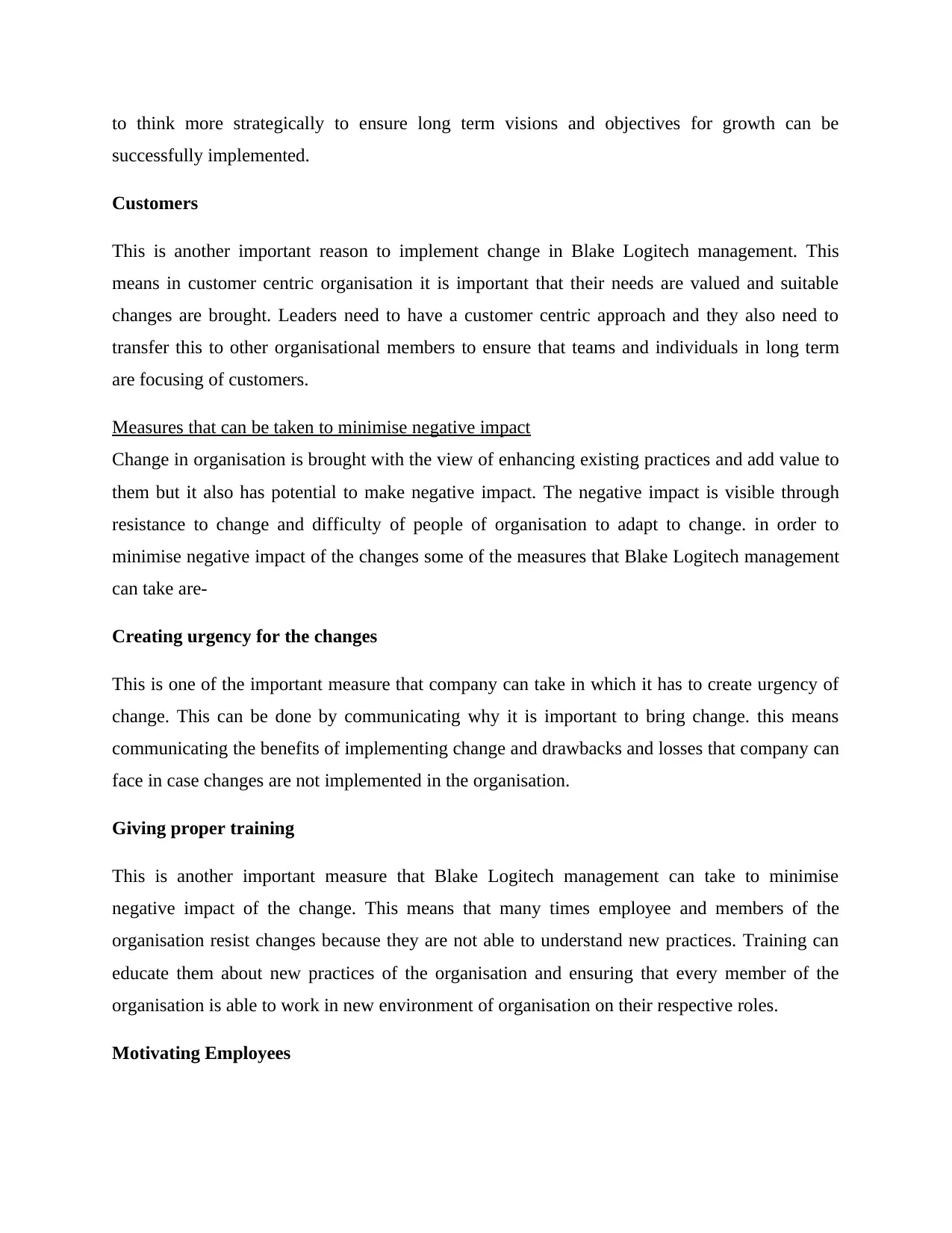
to think more strategically to ensure long term visions and objectives for growth can be
successfully implemented.
Customers
This is another important reason to implement change in Blake Logitech management. This
means in customer centric organisation it is important that their needs are valued and suitable
changes are brought. Leaders need to have a customer centric approach and they also need to
transfer this to other organisational members to ensure that teams and individuals in long term
are focusing of customers.
Measures that can be taken to minimise negative impact
Change in organisation is brought with the view of enhancing existing practices and add value to
them but it also has potential to make negative impact. The negative impact is visible through
resistance to change and difficulty of people of organisation to adapt to change. in order to
minimise negative impact of the changes some of the measures that Blake Logitech management
can take are-
Creating urgency for the changes
This is one of the important measure that company can take in which it has to create urgency of
change. This can be done by communicating why it is important to bring change. this means
communicating the benefits of implementing change and drawbacks and losses that company can
face in case changes are not implemented in the organisation.
Giving proper training
This is another important measure that Blake Logitech management can take to minimise
negative impact of the change. This means that many times employee and members of the
organisation resist changes because they are not able to understand new practices. Training can
educate them about new practices of the organisation and ensuring that every member of the
organisation is able to work in new environment of organisation on their respective roles.
Motivating Employees
successfully implemented.
Customers
This is another important reason to implement change in Blake Logitech management. This
means in customer centric organisation it is important that their needs are valued and suitable
changes are brought. Leaders need to have a customer centric approach and they also need to
transfer this to other organisational members to ensure that teams and individuals in long term
are focusing of customers.
Measures that can be taken to minimise negative impact
Change in organisation is brought with the view of enhancing existing practices and add value to
them but it also has potential to make negative impact. The negative impact is visible through
resistance to change and difficulty of people of organisation to adapt to change. in order to
minimise negative impact of the changes some of the measures that Blake Logitech management
can take are-
Creating urgency for the changes
This is one of the important measure that company can take in which it has to create urgency of
change. This can be done by communicating why it is important to bring change. this means
communicating the benefits of implementing change and drawbacks and losses that company can
face in case changes are not implemented in the organisation.
Giving proper training
This is another important measure that Blake Logitech management can take to minimise
negative impact of the change. This means that many times employee and members of the
organisation resist changes because they are not able to understand new practices. Training can
educate them about new practices of the organisation and ensuring that every member of the
organisation is able to work in new environment of organisation on their respective roles.
Motivating Employees
Paraphrase This Document
Need a fresh take? Get an instant paraphrase of this document with our AI Paraphraser
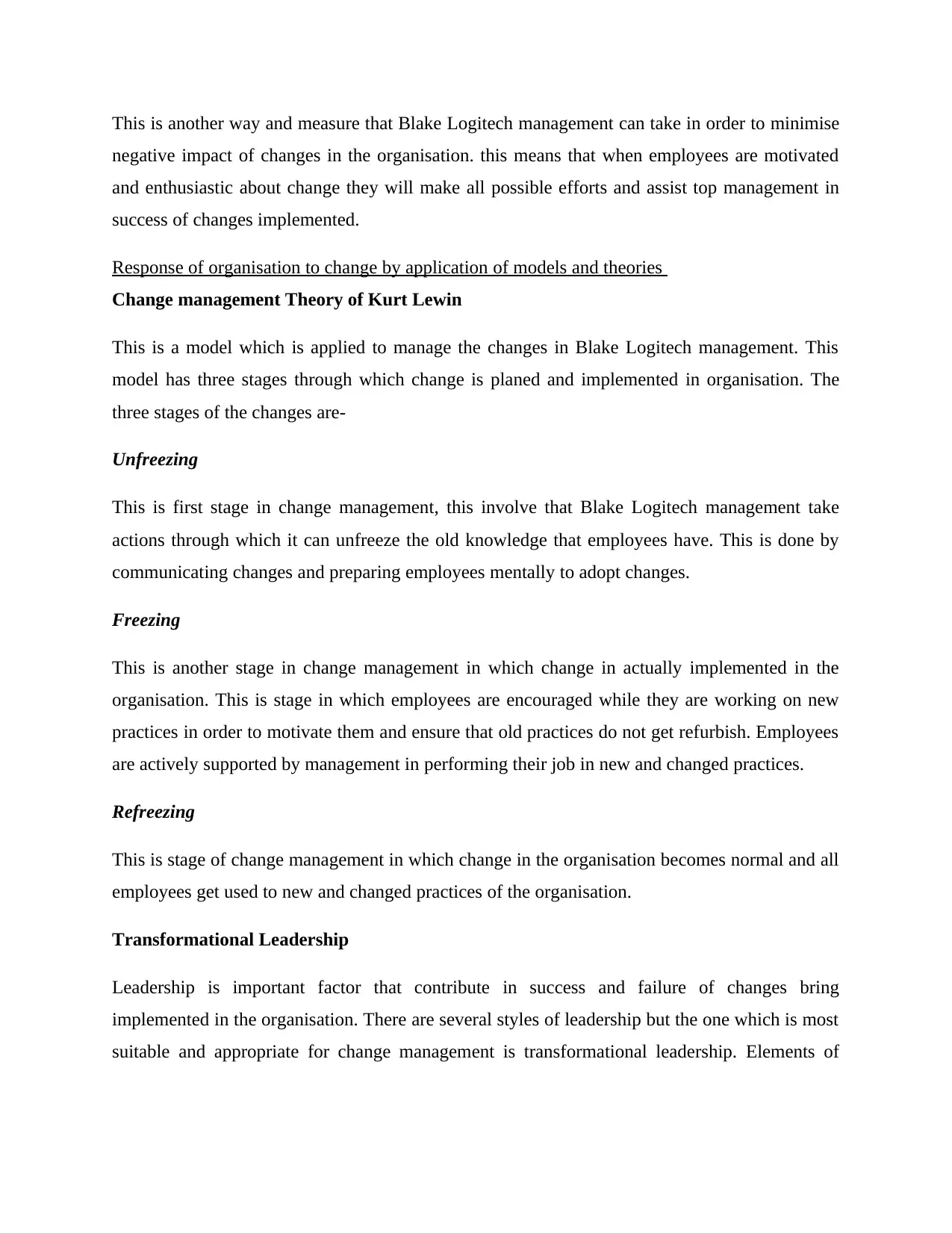
This is another way and measure that Blake Logitech management can take in order to minimise
negative impact of changes in the organisation. this means that when employees are motivated
and enthusiastic about change they will make all possible efforts and assist top management in
success of changes implemented.
Response of organisation to change by application of models and theories
Change management Theory of Kurt Lewin
This is a model which is applied to manage the changes in Blake Logitech management. This
model has three stages through which change is planed and implemented in organisation. The
three stages of the changes are-
Unfreezing
This is first stage in change management, this involve that Blake Logitech management take
actions through which it can unfreeze the old knowledge that employees have. This is done by
communicating changes and preparing employees mentally to adopt changes.
Freezing
This is another stage in change management in which change in actually implemented in the
organisation. This is stage in which employees are encouraged while they are working on new
practices in order to motivate them and ensure that old practices do not get refurbish. Employees
are actively supported by management in performing their job in new and changed practices.
Refreezing
This is stage of change management in which change in the organisation becomes normal and all
employees get used to new and changed practices of the organisation.
Transformational Leadership
Leadership is important factor that contribute in success and failure of changes bring
implemented in the organisation. There are several styles of leadership but the one which is most
suitable and appropriate for change management is transformational leadership. Elements of
negative impact of changes in the organisation. this means that when employees are motivated
and enthusiastic about change they will make all possible efforts and assist top management in
success of changes implemented.
Response of organisation to change by application of models and theories
Change management Theory of Kurt Lewin
This is a model which is applied to manage the changes in Blake Logitech management. This
model has three stages through which change is planed and implemented in organisation. The
three stages of the changes are-
Unfreezing
This is first stage in change management, this involve that Blake Logitech management take
actions through which it can unfreeze the old knowledge that employees have. This is done by
communicating changes and preparing employees mentally to adopt changes.
Freezing
This is another stage in change management in which change in actually implemented in the
organisation. This is stage in which employees are encouraged while they are working on new
practices in order to motivate them and ensure that old practices do not get refurbish. Employees
are actively supported by management in performing their job in new and changed practices.
Refreezing
This is stage of change management in which change in the organisation becomes normal and all
employees get used to new and changed practices of the organisation.
Transformational Leadership
Leadership is important factor that contribute in success and failure of changes bring
implemented in the organisation. There are several styles of leadership but the one which is most
suitable and appropriate for change management is transformational leadership. Elements of
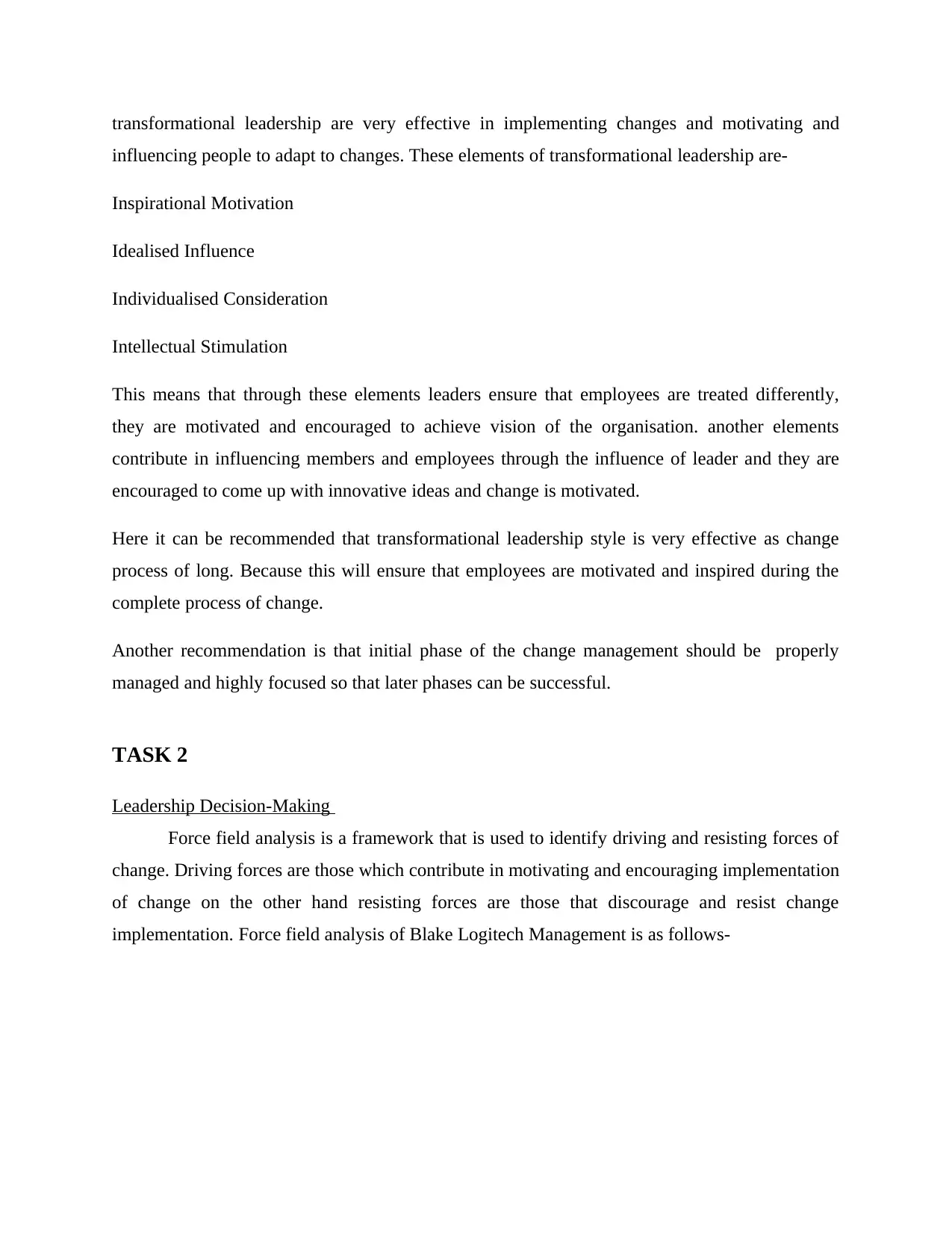
transformational leadership are very effective in implementing changes and motivating and
influencing people to adapt to changes. These elements of transformational leadership are-
Inspirational Motivation
Idealised Influence
Individualised Consideration
Intellectual Stimulation
This means that through these elements leaders ensure that employees are treated differently,
they are motivated and encouraged to achieve vision of the organisation. another elements
contribute in influencing members and employees through the influence of leader and they are
encouraged to come up with innovative ideas and change is motivated.
Here it can be recommended that transformational leadership style is very effective as change
process of long. Because this will ensure that employees are motivated and inspired during the
complete process of change.
Another recommendation is that initial phase of the change management should be properly
managed and highly focused so that later phases can be successful.
TASK 2
Leadership Decision-Making
Force field analysis is a framework that is used to identify driving and resisting forces of
change. Driving forces are those which contribute in motivating and encouraging implementation
of change on the other hand resisting forces are those that discourage and resist change
implementation. Force field analysis of Blake Logitech Management is as follows-
influencing people to adapt to changes. These elements of transformational leadership are-
Inspirational Motivation
Idealised Influence
Individualised Consideration
Intellectual Stimulation
This means that through these elements leaders ensure that employees are treated differently,
they are motivated and encouraged to achieve vision of the organisation. another elements
contribute in influencing members and employees through the influence of leader and they are
encouraged to come up with innovative ideas and change is motivated.
Here it can be recommended that transformational leadership style is very effective as change
process of long. Because this will ensure that employees are motivated and inspired during the
complete process of change.
Another recommendation is that initial phase of the change management should be properly
managed and highly focused so that later phases can be successful.
TASK 2
Leadership Decision-Making
Force field analysis is a framework that is used to identify driving and resisting forces of
change. Driving forces are those which contribute in motivating and encouraging implementation
of change on the other hand resisting forces are those that discourage and resist change
implementation. Force field analysis of Blake Logitech Management is as follows-
⊘ This is a preview!⊘
Do you want full access?
Subscribe today to unlock all pages.

Trusted by 1+ million students worldwide
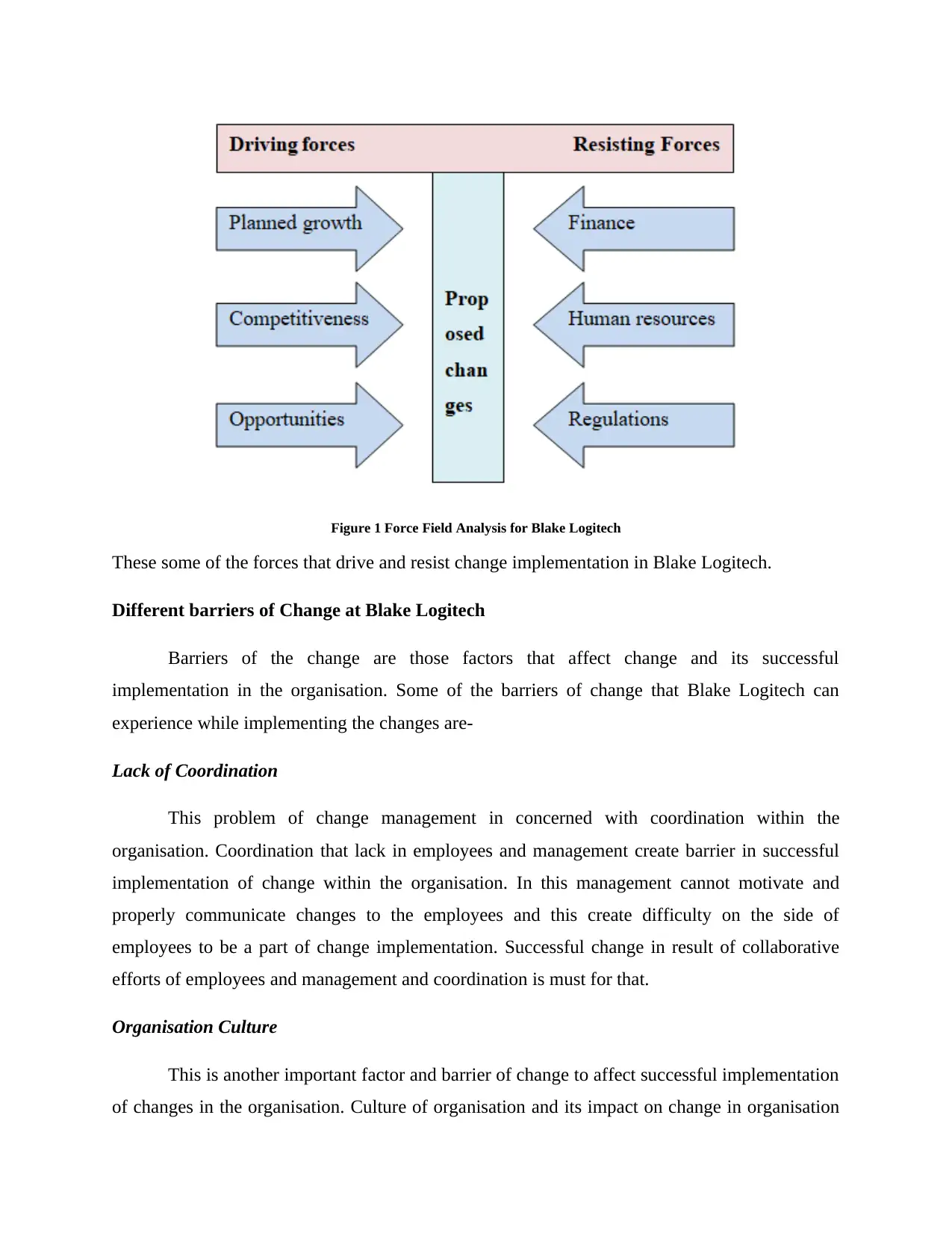
Figure 1 Force Field Analysis for Blake Logitech
These some of the forces that drive and resist change implementation in Blake Logitech.
Different barriers of Change at Blake Logitech
Barriers of the change are those factors that affect change and its successful
implementation in the organisation. Some of the barriers of change that Blake Logitech can
experience while implementing the changes are-
Lack of Coordination
This problem of change management in concerned with coordination within the
organisation. Coordination that lack in employees and management create barrier in successful
implementation of change within the organisation. In this management cannot motivate and
properly communicate changes to the employees and this create difficulty on the side of
employees to be a part of change implementation. Successful change in result of collaborative
efforts of employees and management and coordination is must for that.
Organisation Culture
This is another important factor and barrier of change to affect successful implementation
of changes in the organisation. Culture of organisation and its impact on change in organisation
These some of the forces that drive and resist change implementation in Blake Logitech.
Different barriers of Change at Blake Logitech
Barriers of the change are those factors that affect change and its successful
implementation in the organisation. Some of the barriers of change that Blake Logitech can
experience while implementing the changes are-
Lack of Coordination
This problem of change management in concerned with coordination within the
organisation. Coordination that lack in employees and management create barrier in successful
implementation of change within the organisation. In this management cannot motivate and
properly communicate changes to the employees and this create difficulty on the side of
employees to be a part of change implementation. Successful change in result of collaborative
efforts of employees and management and coordination is must for that.
Organisation Culture
This is another important factor and barrier of change to affect successful implementation
of changes in the organisation. Culture of organisation and its impact on change in organisation
Paraphrase This Document
Need a fresh take? Get an instant paraphrase of this document with our AI Paraphraser
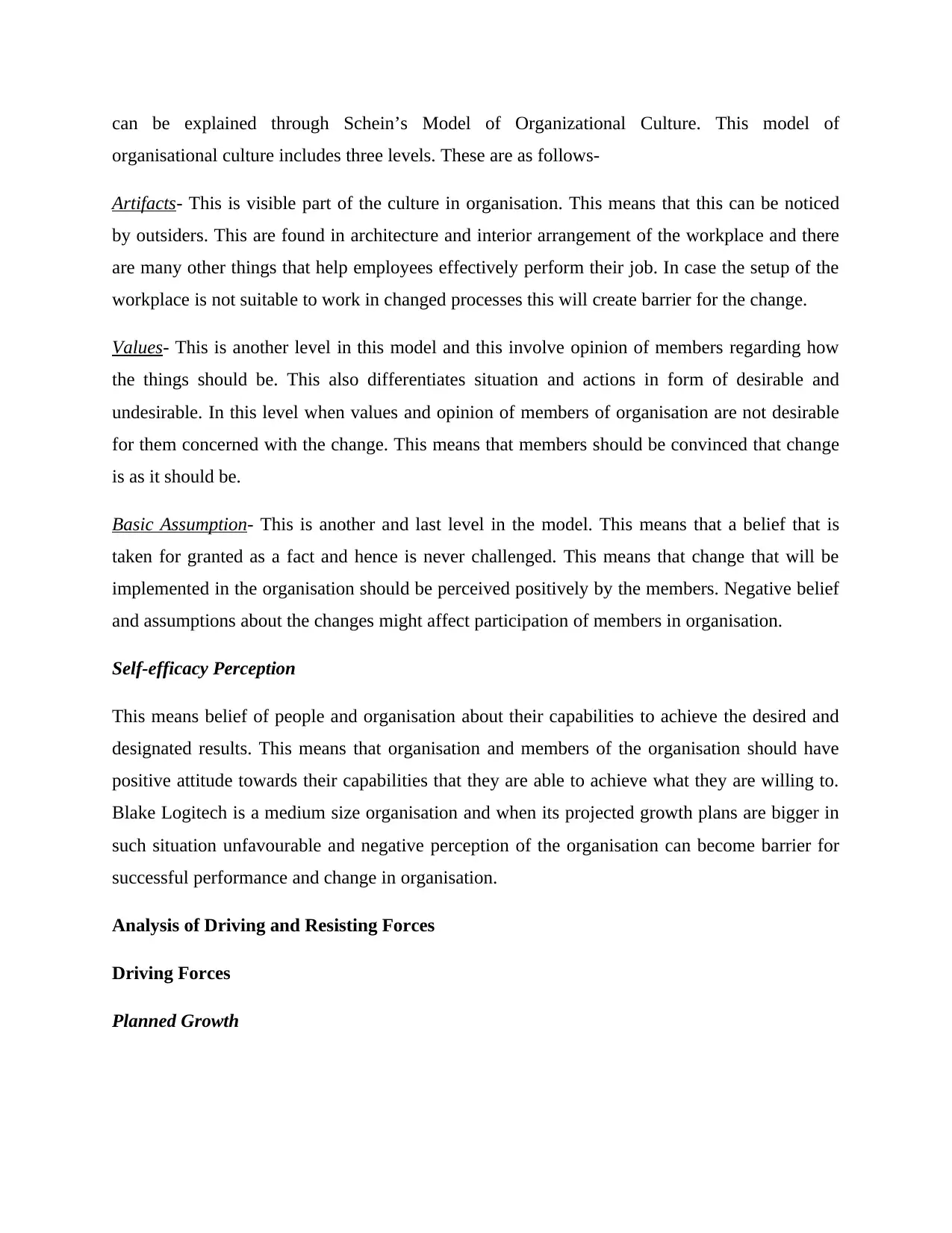
can be explained through Schein’s Model of Organizational Culture. This model of
organisational culture includes three levels. These are as follows-
Artifacts- This is visible part of the culture in organisation. This means that this can be noticed
by outsiders. This are found in architecture and interior arrangement of the workplace and there
are many other things that help employees effectively perform their job. In case the setup of the
workplace is not suitable to work in changed processes this will create barrier for the change.
Values- This is another level in this model and this involve opinion of members regarding how
the things should be. This also differentiates situation and actions in form of desirable and
undesirable. In this level when values and opinion of members of organisation are not desirable
for them concerned with the change. This means that members should be convinced that change
is as it should be.
Basic Assumption- This is another and last level in the model. This means that a belief that is
taken for granted as a fact and hence is never challenged. This means that change that will be
implemented in the organisation should be perceived positively by the members. Negative belief
and assumptions about the changes might affect participation of members in organisation.
Self-efficacy Perception
This means belief of people and organisation about their capabilities to achieve the desired and
designated results. This means that organisation and members of the organisation should have
positive attitude towards their capabilities that they are able to achieve what they are willing to.
Blake Logitech is a medium size organisation and when its projected growth plans are bigger in
such situation unfavourable and negative perception of the organisation can become barrier for
successful performance and change in organisation.
Analysis of Driving and Resisting Forces
Driving Forces
Planned Growth
organisational culture includes three levels. These are as follows-
Artifacts- This is visible part of the culture in organisation. This means that this can be noticed
by outsiders. This are found in architecture and interior arrangement of the workplace and there
are many other things that help employees effectively perform their job. In case the setup of the
workplace is not suitable to work in changed processes this will create barrier for the change.
Values- This is another level in this model and this involve opinion of members regarding how
the things should be. This also differentiates situation and actions in form of desirable and
undesirable. In this level when values and opinion of members of organisation are not desirable
for them concerned with the change. This means that members should be convinced that change
is as it should be.
Basic Assumption- This is another and last level in the model. This means that a belief that is
taken for granted as a fact and hence is never challenged. This means that change that will be
implemented in the organisation should be perceived positively by the members. Negative belief
and assumptions about the changes might affect participation of members in organisation.
Self-efficacy Perception
This means belief of people and organisation about their capabilities to achieve the desired and
designated results. This means that organisation and members of the organisation should have
positive attitude towards their capabilities that they are able to achieve what they are willing to.
Blake Logitech is a medium size organisation and when its projected growth plans are bigger in
such situation unfavourable and negative perception of the organisation can become barrier for
successful performance and change in organisation.
Analysis of Driving and Resisting Forces
Driving Forces
Planned Growth
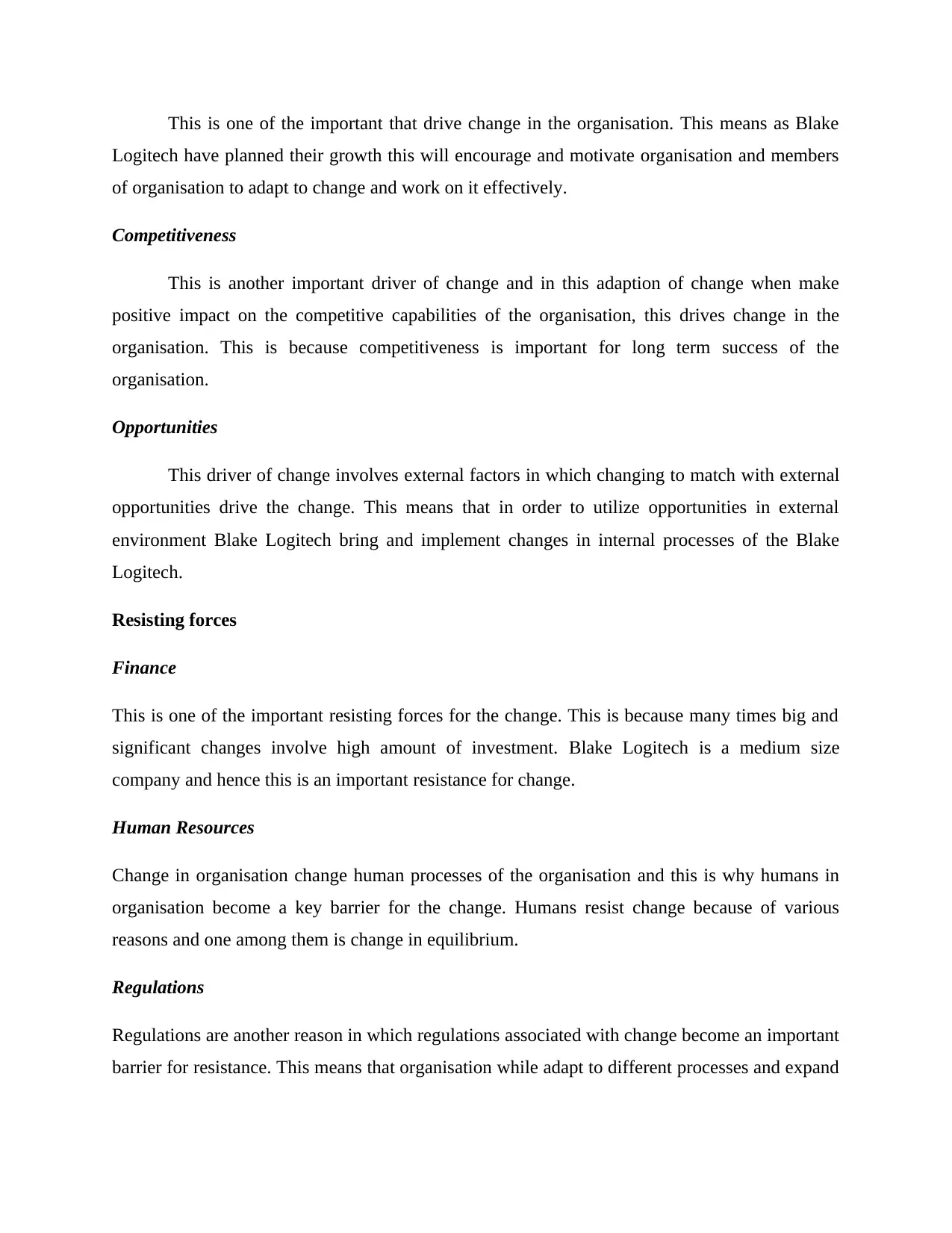
This is one of the important that drive change in the organisation. This means as Blake
Logitech have planned their growth this will encourage and motivate organisation and members
of organisation to adapt to change and work on it effectively.
Competitiveness
This is another important driver of change and in this adaption of change when make
positive impact on the competitive capabilities of the organisation, this drives change in the
organisation. This is because competitiveness is important for long term success of the
organisation.
Opportunities
This driver of change involves external factors in which changing to match with external
opportunities drive the change. This means that in order to utilize opportunities in external
environment Blake Logitech bring and implement changes in internal processes of the Blake
Logitech.
Resisting forces
Finance
This is one of the important resisting forces for the change. This is because many times big and
significant changes involve high amount of investment. Blake Logitech is a medium size
company and hence this is an important resistance for change.
Human Resources
Change in organisation change human processes of the organisation and this is why humans in
organisation become a key barrier for the change. Humans resist change because of various
reasons and one among them is change in equilibrium.
Regulations
Regulations are another reason in which regulations associated with change become an important
barrier for resistance. This means that organisation while adapt to different processes and expand
Logitech have planned their growth this will encourage and motivate organisation and members
of organisation to adapt to change and work on it effectively.
Competitiveness
This is another important driver of change and in this adaption of change when make
positive impact on the competitive capabilities of the organisation, this drives change in the
organisation. This is because competitiveness is important for long term success of the
organisation.
Opportunities
This driver of change involves external factors in which changing to match with external
opportunities drive the change. This means that in order to utilize opportunities in external
environment Blake Logitech bring and implement changes in internal processes of the Blake
Logitech.
Resisting forces
Finance
This is one of the important resisting forces for the change. This is because many times big and
significant changes involve high amount of investment. Blake Logitech is a medium size
company and hence this is an important resistance for change.
Human Resources
Change in organisation change human processes of the organisation and this is why humans in
organisation become a key barrier for the change. Humans resist change because of various
reasons and one among them is change in equilibrium.
Regulations
Regulations are another reason in which regulations associated with change become an important
barrier for resistance. This means that organisation while adapt to different processes and expand
⊘ This is a preview!⊘
Do you want full access?
Subscribe today to unlock all pages.

Trusted by 1+ million students worldwide
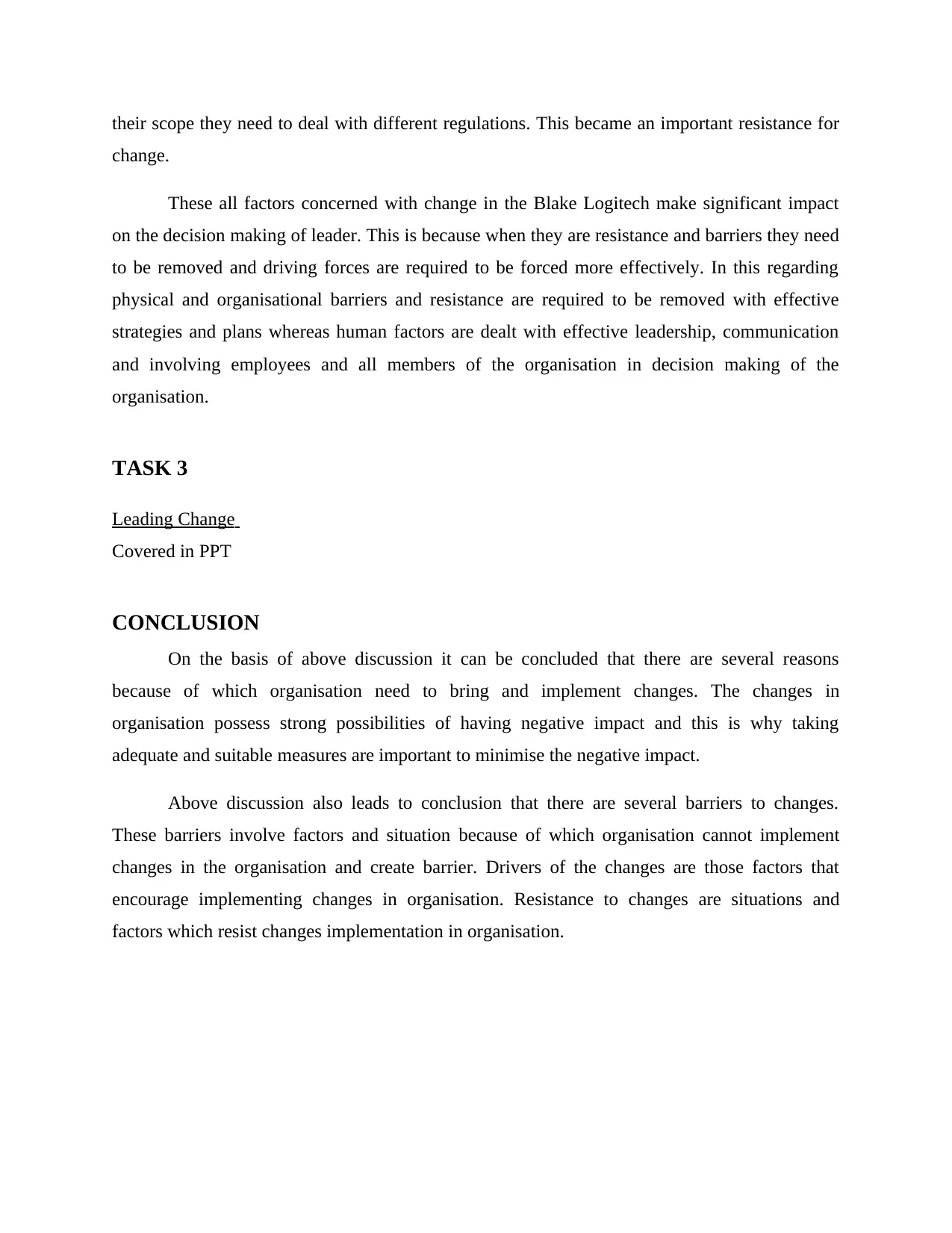
their scope they need to deal with different regulations. This became an important resistance for
change.
These all factors concerned with change in the Blake Logitech make significant impact
on the decision making of leader. This is because when they are resistance and barriers they need
to be removed and driving forces are required to be forced more effectively. In this regarding
physical and organisational barriers and resistance are required to be removed with effective
strategies and plans whereas human factors are dealt with effective leadership, communication
and involving employees and all members of the organisation in decision making of the
organisation.
TASK 3
Leading Change
Covered in PPT
CONCLUSION
On the basis of above discussion it can be concluded that there are several reasons
because of which organisation need to bring and implement changes. The changes in
organisation possess strong possibilities of having negative impact and this is why taking
adequate and suitable measures are important to minimise the negative impact.
Above discussion also leads to conclusion that there are several barriers to changes.
These barriers involve factors and situation because of which organisation cannot implement
changes in the organisation and create barrier. Drivers of the changes are those factors that
encourage implementing changes in organisation. Resistance to changes are situations and
factors which resist changes implementation in organisation.
change.
These all factors concerned with change in the Blake Logitech make significant impact
on the decision making of leader. This is because when they are resistance and barriers they need
to be removed and driving forces are required to be forced more effectively. In this regarding
physical and organisational barriers and resistance are required to be removed with effective
strategies and plans whereas human factors are dealt with effective leadership, communication
and involving employees and all members of the organisation in decision making of the
organisation.
TASK 3
Leading Change
Covered in PPT
CONCLUSION
On the basis of above discussion it can be concluded that there are several reasons
because of which organisation need to bring and implement changes. The changes in
organisation possess strong possibilities of having negative impact and this is why taking
adequate and suitable measures are important to minimise the negative impact.
Above discussion also leads to conclusion that there are several barriers to changes.
These barriers involve factors and situation because of which organisation cannot implement
changes in the organisation and create barrier. Drivers of the changes are those factors that
encourage implementing changes in organisation. Resistance to changes are situations and
factors which resist changes implementation in organisation.
Paraphrase This Document
Need a fresh take? Get an instant paraphrase of this document with our AI Paraphraser
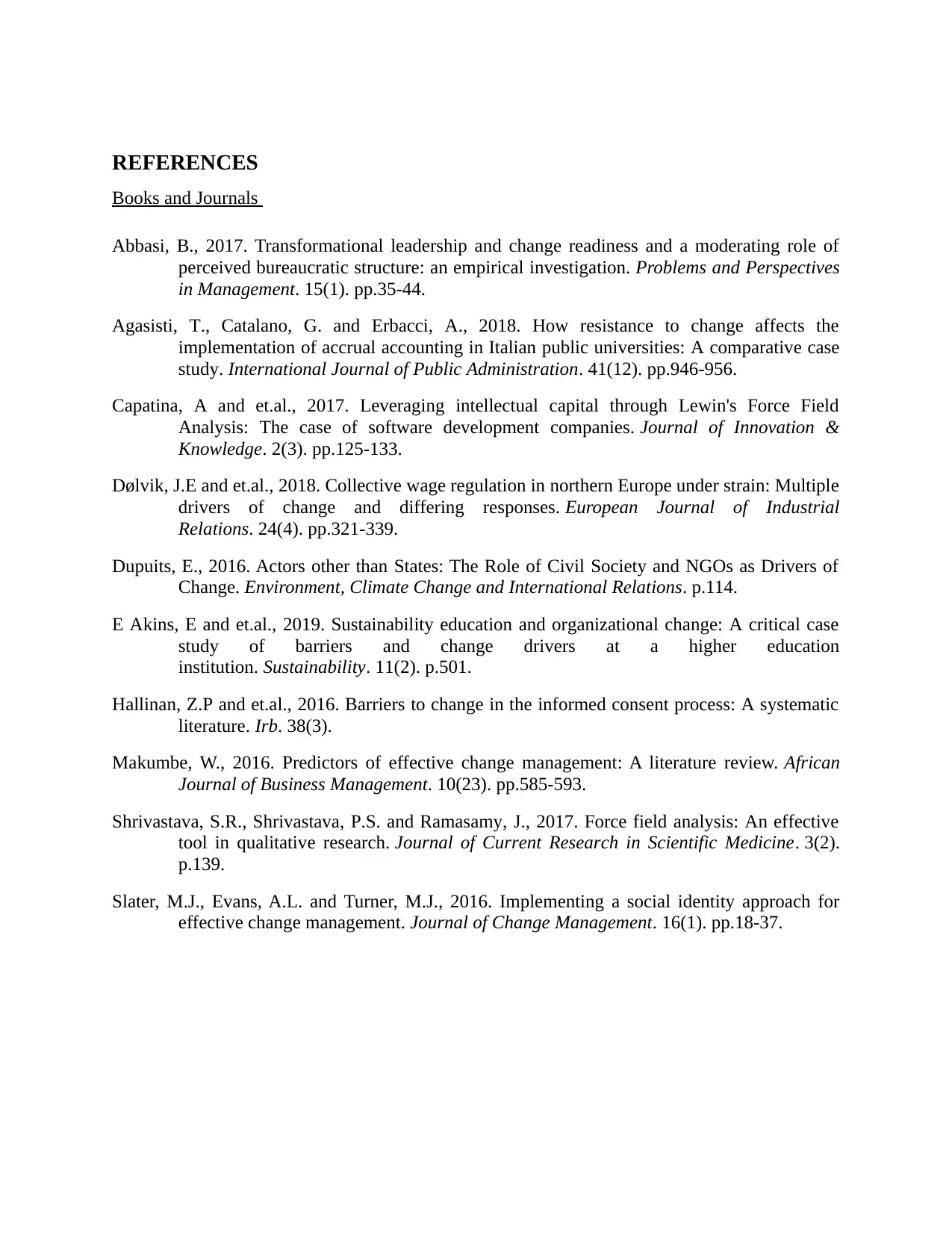
REFERENCES
Books and Journals
Abbasi, B., 2017. Transformational leadership and change readiness and a moderating role of
perceived bureaucratic structure: an empirical investigation. Problems and Perspectives
in Management. 15(1). pp.35-44.
Agasisti, T., Catalano, G. and Erbacci, A., 2018. How resistance to change affects the
implementation of accrual accounting in Italian public universities: A comparative case
study. International Journal of Public Administration. 41(12). pp.946-956.
Capatina, A and et.al., 2017. Leveraging intellectual capital through Lewin's Force Field
Analysis: The case of software development companies. Journal of Innovation &
Knowledge. 2(3). pp.125-133.
Dølvik, J.E and et.al., 2018. Collective wage regulation in northern Europe under strain: Multiple
drivers of change and differing responses. European Journal of Industrial
Relations. 24(4). pp.321-339.
Dupuits, E., 2016. Actors other than States: The Role of Civil Society and NGOs as Drivers of
Change. Environment, Climate Change and International Relations. p.114.
E Akins, E and et.al., 2019. Sustainability education and organizational change: A critical case
study of barriers and change drivers at a higher education
institution. Sustainability. 11(2). p.501.
Hallinan, Z.P and et.al., 2016. Barriers to change in the informed consent process: A systematic
literature. Irb. 38(3).
Makumbe, W., 2016. Predictors of effective change management: A literature review. African
Journal of Business Management. 10(23). pp.585-593.
Shrivastava, S.R., Shrivastava, P.S. and Ramasamy, J., 2017. Force field analysis: An effective
tool in qualitative research. Journal of Current Research in Scientific Medicine. 3(2).
p.139.
Slater, M.J., Evans, A.L. and Turner, M.J., 2016. Implementing a social identity approach for
effective change management. Journal of Change Management. 16(1). pp.18-37.
Books and Journals
Abbasi, B., 2017. Transformational leadership and change readiness and a moderating role of
perceived bureaucratic structure: an empirical investigation. Problems and Perspectives
in Management. 15(1). pp.35-44.
Agasisti, T., Catalano, G. and Erbacci, A., 2018. How resistance to change affects the
implementation of accrual accounting in Italian public universities: A comparative case
study. International Journal of Public Administration. 41(12). pp.946-956.
Capatina, A and et.al., 2017. Leveraging intellectual capital through Lewin's Force Field
Analysis: The case of software development companies. Journal of Innovation &
Knowledge. 2(3). pp.125-133.
Dølvik, J.E and et.al., 2018. Collective wage regulation in northern Europe under strain: Multiple
drivers of change and differing responses. European Journal of Industrial
Relations. 24(4). pp.321-339.
Dupuits, E., 2016. Actors other than States: The Role of Civil Society and NGOs as Drivers of
Change. Environment, Climate Change and International Relations. p.114.
E Akins, E and et.al., 2019. Sustainability education and organizational change: A critical case
study of barriers and change drivers at a higher education
institution. Sustainability. 11(2). p.501.
Hallinan, Z.P and et.al., 2016. Barriers to change in the informed consent process: A systematic
literature. Irb. 38(3).
Makumbe, W., 2016. Predictors of effective change management: A literature review. African
Journal of Business Management. 10(23). pp.585-593.
Shrivastava, S.R., Shrivastava, P.S. and Ramasamy, J., 2017. Force field analysis: An effective
tool in qualitative research. Journal of Current Research in Scientific Medicine. 3(2).
p.139.
Slater, M.J., Evans, A.L. and Turner, M.J., 2016. Implementing a social identity approach for
effective change management. Journal of Change Management. 16(1). pp.18-37.
1 out of 11
Related Documents
Your All-in-One AI-Powered Toolkit for Academic Success.
+13062052269
info@desklib.com
Available 24*7 on WhatsApp / Email
![[object Object]](/_next/static/media/star-bottom.7253800d.svg)
Unlock your academic potential
Copyright © 2020–2025 A2Z Services. All Rights Reserved. Developed and managed by ZUCOL.





